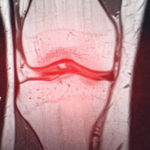The Epigenetics of Synovitis

Kathryn Weinand, PhD candidate, Raychaudhuri Lab
The second speaker in the session, Kathryn Weinand, PhD candidate, Raychaudhuri Lab, Harvard Medical School, Boston, she spoke on the subject of the epigenetics of synovitis. Ms. Weinand began with a discussion of the basics of transcription, the process by which a strand of DNA is copied into a new molecule in the form of messenger RNA (mRNA). The process of transcription is carried out by the enzyme RNA polymerase and accessory proteins called transcription factors (together, these form the transcription initiation complex). Enhancer and promoter sequences are regions of DNA to which transcription factors can bind and, thus, these sequences help direct where transcription should begin. One essential aspect of this process is that genes must be in accessible chromatin (AKA open chromatin) in order to be transcribed.
Ms. Weinand noted that, although genome-wide association studies (GWAS) have identified many variants that appear to have possible associations with rheumatoid arthritis, about 90% of these GWAS variants are located in non-coding genome regions and, thus, do not directly affect the coding sequence of a gene. Rather, these variants can accumulate in DNA regulatory elements, interfere with binding sites for transcription factors, and thus regulate gene expression levels in a cell type-specific manner.3
While earlier work from researchers like Dr. Rao have identified the important cell populations present and expanded in RA tissue inflammation, Ms. Weinand and colleagues have sought to investigate the chromatin accessibility profiles that underlie these pathogenic synovial tissue cell states. She and her collaborators measured genome-wide open chromatin at single cell resolution from 30 synovial tissue samples; 12 of these samples also had transcriptional data in multimodal experiments. The team was able to define 24 chromatin classes across 5 broad cell types and, by integrating a RA tissue transcriptional atlas into their analysis, they found that chromatin classes represent what they termed “superstates” that correspond to multiple transcription cell states.
Ms. Weinand explained how understanding this relationship between transcriptional cell state and chromatin class can have implications for therapies in rheumatoid arthritis. For example, treatment with rituximab, a B cell-depleting antibody, is meant to result in the deletion of a pathogenic cell (i.e., the B cell). However, if one chromatin class corresponds to multiple transcriptional cell states, then deleting just one pathogenic cell population may not be effective since other non-pathogenic transcriptional cell states can transition into that same pathogenic cell state given that the overall tissue environment remains the same. Therefore, altering the tissue environment or removing exogenous factors, such as transcription factors and cytokines, may prove more effective.4 Understanding these upstream and downstream effects thus may hold great promise in more successfully treating RA in many patients.
